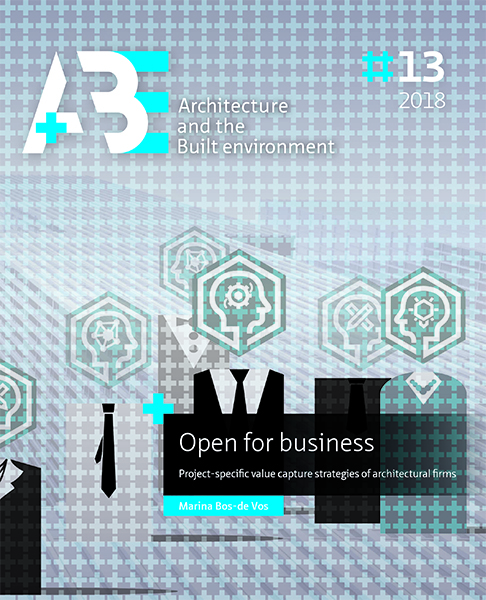Introduction
DOI:
https://doi.org/10.7480/abe.2018.13.3555Abstract
Driven by their desire to contribute to the quality of the built environment and wider society, architectural firms collaborate with other actors in heterogeneous interorganizational projects to provide products and services that solve complex spatial challenges. Due to ongoing developments in society and the construction industry, the professional roles that firms perform within these projects have become increasingly diverse, blurred and contested (Ahuja et al., 2017). While the role of architectural firms historically was clearly defined (Burr and Jones, 2010; Jones and Lichtenstein, 2008), they now cover a broad spectrum of activities and responsibilities, ranging from ‘full-service’ providers to specialist advisors for a certain discipline or phase (Duffy and Rabeneck, 2013; Van Doorn, 2014). The diversity in, and ongoing pressure on, roles often leads to firms experiencing difficulties when co-creating or capturing value in projects. For example, firms are not always able to realize the level of quality that they pursue, or fail to make a decent living out of their service delivery. While attempting to reconcile the demands of the many stakeholders that are involved in projects, architectural firms struggle to realize their professional and commercial goals.
Research in the field of management has shown that the simultaneous use of multiple business models helps firms to deal with different demands and opportunities when operating in diverse contexts (Aversa et al., 2015; Kujala et al., 2010; Sabatier et al., 2010). Constant innovation of these business models further contributes to the resilience of organizations (Chesbrough, 2010). Although business model theory has significantly contributed to the understanding of organizations and their collaboration in the value chain, existing theories have been largely developed on the basis of insights from traditional, entrepreneurial firms (Zott et al., 2011). As a result, business model theory primarily addresses how organizations generate financial revenues from the value that they co-create. Considering that organizations’ single-minded pursuit of profits is increasingly constrained by other important goals, such as social responsibility (Thompson and MacMillan, 2010), more insight is needed into how organizations might capture multiple dimensions of value through their business models. Businesses that by nature pursue multiple strategic goals, such as architectural firms or other creative and/or professional service firms, represent an interesting empirical context for such investigations.
This research aims to generate insight into the value capture process of architectural firms:
1) to contribute to the understanding of how firms capture multiple dimensions of value in project contexts in order to realize their strategic goals; and
2) to support architectural firms in dealing with the value capture challenges they face in practice.
The following two main research questions are used to address the aims of the research:
1 How do architectural firms capture value in construction projects?
2 How can architectural firms be supported in developing strategies for value capture?
I chose to focus specifically on firms’ value capture in projects to gain detailed, context-specific insights into the challenges and opportunities that firms encounter when attempting to balance multiple strategic goals. Multiple construction projects were studied to reveal overarching patterns in the value capture strategies of different architectural firms, across different project settings. The research draws on 25 interviews with architects and 15 interviews with clients from 24 recently completed construction projects, as well as observational data from 17 project-oriented strategy meetings to examine architectural firms’ value capture strategies both in retrospect and as they unfold in practice.
Based on an engaged scholarship approach (Van de Ven, 2007), I used my own background and continued involvement in architectural practice to conduct my research. The empirical insights gained were further developed into a value capture toolkit that can be used by architectural firms to engage in projects and manage their value capture activities in these projects with greater awareness. The empirical research findings and toolkit were validated on a regular basis in conferences, discussion groups and co-organized workshops with different academic and professional communities.
In the remainder of this introduction, I will first present and discuss the theoretical background, which combines a project-oriented perspective on business and a multidimensional perspective on value. The research’s scientific, practical and societal relevance will then be discussed. Subsequently, I will present the research context, paying specific attention to the roles of architectural firms in construction projects, which served as an empirical setting, and the overarching research project, futurA, in which the research is embedded. Following this, the methodological approach is discussed, with a particular focus on why a combination of empirical and design-oriented research is useful to increase our understanding of value capture by architectural firms and other creative and/or professional service firms. The introduction concludes with an overview of the remaining chapters and how they are related.

